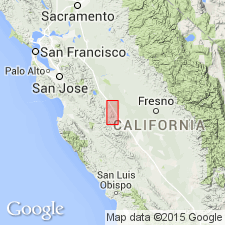
- Usage in publication:
-
- Mercy sandstone lentil
- Modifications:
-
- Principal reference
- Dominant lithology:
-
- Sandstone
- AAPG geologic province:
-
- San Joaquin basin
Summary:
Pg. 6 (fig. 2), 8 (fig. 4), 9, 24. See also 1941 [abs.], GSA Bull., v. 52, no. 12, pt. 2, p. 1954. Mercy sandstone lentil in Tierra Loma shale member of Moreno formation. Fine-grained, micaceous, massive, platy, concretionary sandstone interbedded with brown shale. Thickness about 190 feet. Occurs 70 feet below the top of the Tierra Loma shale member (new). Fossils (arenaceous foraminifers). Age is Late Cretaceous. On the basis of this mapping it is concluded that Anderson and Pack (1915) show base of Moreno formation in [Ortegalito] Creek some 1,800 feet stratigraphically lower than their type Moreno in Moreno Gulch.
Type locality: Mercy Canyon [unlabeled], in sec. 15, T. 16 S., R. 12 E., Tumey Hills, [Tumey Hills 7.5-min quadrangle], Fresno Co., southern CA. Named from Mercy Hot Springs [now Mercey Hot Springs; in southeastern corner sec. 15, T. 14 S., R. 10 E., Mercey Hot Springs 7.5-min quadrangle, Fresno Co., southern CA, 10+ mi northwest of type locality].
[Additional locality information from USGS GNIS database and USGS historical topographic map collection TopoView, accessed January 20, 2018.]
Source: Publication; US geologic names lexicon (USGS Bull. 1200, p. 2467).
For more information, please contact Nancy Stamm, Geologic Names Committee Secretary.
Asterisk (*) indicates published by U.S. Geological Survey authors.
"No current usage" (†) implies that a name has been abandoned or has fallen into disuse. Former usage and, if known, replacement name given in parentheses ( ).
Slash (/) indicates name conflicts with nomenclatural guidelines (CSN, 1933; ACSN, 1961, 1970; NACSN, 1983, 2005, 2021). May be explained within brackets ([ ]).

